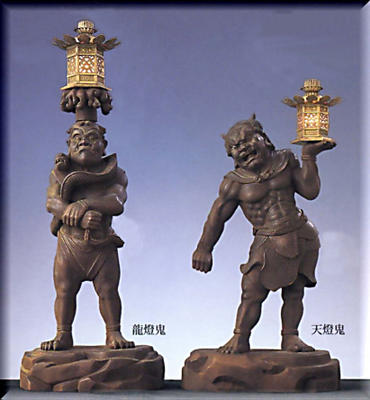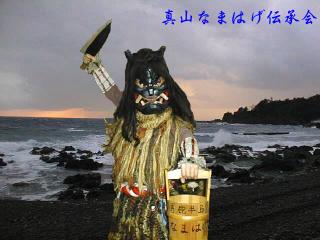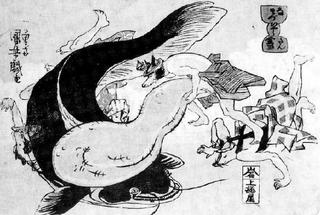. Onipedia - 鬼ペディア - Oni Demons - ABC-List - .
:::::::::::::::::::::::::::::::::::::::::::::::::::::::::::::::::::::::::::::::::::::::::::::::::::::
.. .. .. .. .. .. .. Oni, the Japanese Demons
A lot of scholarly material is already out on this topic, so I give you a short overview later on about useful links. Here I will introduce mostly some of my favorite Oni 鬼.

Setsubun on February 3 is the time to think about Demons.
Oni wa soto, Fuku wa uchi !
Demons, out you go! Good Luck, please come in!
On February 3rd of 2005, Setsubun will be celebrated throughout Japan. Falling at the end of the period defined by the solar principal term Daikan (Severe Cold), Setsubun occurs one day before the sectional term Risshun (Spring Begins). The setsu of Setsubun (literally "sectional separation") originally referred to the eve of any of the 24 divisions of the solar year (see
The Lunar Calendar in Japan for an explanation of these divisions). However, the Setsubun associated with "Spring Begins" gained significance as a symbol of Toshi Koshi (year passing) or Jyo Jitsu (accepting the old year) by marking the completion of the cycle of the 24 divisions of the solar year. Only this Setsubun is still marked on the official calendar.
Setsubun achieved the status of an imperial event and further took on symbolic and ritual significance relative to its association with prospects for a "returning sun", associated climatic change, renewal of body and mind, expulsion of evil, symbolic rebirth, and preparation for the coming planting season. Customs surrounding this day apparently date as early as the Ming Dynasty in China, and in Japanese form, began to take shape in the Muromachi Era (1392-1573).
Setsubun has been celebrated in many ways, but perhaps the most common custom found throughout Japan is the traditional
Mame Maki or the scattering/throwing of beans (mame) to chase away the evil oni (ogres, evil spirits). In some ritual forms, the Toshi Otoko [literally "year man" but referring either to the "man of the house" or to men who are born in the animal sign of the coming year (bird for the year 2005)] will throw mame within the house or at someone perhaps dressed as oni and repeat the saying
Oni wa Soto; Fuku wa Uchi (Get out Ogre! Come in Happiness!).
After the ritual throwing of the beans, family members may then pick up the number of beans corresponding to their age; eating these brings assurance of good fortune in the coming year. These days, of course, it is not uncommon to see children dressed in masks of oni, others madly throwing beans, and all gleefully shouting for evil to hit the road. Prominent temples in Japan may also find monks or celebrities showering large crowds of people with mame to ward off spirits and welcome the renewal of the coming New Year.
Read more about this Spring festival.
http://www2.gol.com/users/stever/setsubun.htm
Safekeep copy:
http://groups.yahoo.com/group/DarumaArchives-002/message/48
At a temple in Kyoto, there are Oni of three colors.
The red one symbolizes Greed, the blue (green) one Anger and the black one stupidity.

2月、京都市上京区の廬山寺では、三色の鬼が舞い踊り、大勢の人々が集まります。この三色の鬼たちは人間の三つの煩悩の象徴で、
aka-oni red demon 赤鬼は「貪欲」、ao-oni blue-green demon 青鬼は「怒り」、黒鬼は「愚痴」を表します。
Take a look here:
http://allabout.co.jp/fashion/colorcoordinate/closeup/CU20020201A/
Useful Collection of LINKS about the Setsubun Festival
http://www.nihongomemo.com/nenchugyoji/setsubun.htm
:::::::::::::::::::::::::::::::::::::::::::::::::::::::::::::::::::::::::::::::::::::::::::::::::::
Now I want to talk about some of my favorite Oni.
.. .. .. 役行者 En no Gyooja and his Demon Servants

En no Gyoja, as you can see on the picture above, is usually flanked by a couple of two demons,
. Zenki 前鬼 and his wife Goki 後鬼 .
These demons promised to En no Gyooja to protect the pilgrims of the area. They had five children, whose families in the x-th generation up to this day have five mountain huts where the pilgrims can rest during their walk from Oomine to Kumano. The business is going on for more than 1300 years now.
Gokijo 後鬼助 san, in the 61 generation, lives in Osaka now and comes back every weekend and holidays to take care of the pilgrims.
I have written more about
En no Gyooja and Yoshino here:
http://darumapilgrim.blogspot.com/2005/01/yoshino.html
............................................................................................
. Ryuutooki 龍燈鬼 Ryutoki .
Dragon-lantern-carrying demon
Lantern carrying Demon, Tentoo-Ki 天燈鬼 Tentoki
They are in the temple Koofuku-Ji in Nara. They teach us the dynamics of "Movement" and "Stillness".
その動と静に対比が大変ユーモラスな仏像作品です。
 http://www.e-horindo.com/butuzou/tokusen/ama.html
Mark Schumacher has more about them:
http://www.onmarkproductions.com/html/shitenno.shtml#tentoki
http://www.e-horindo.com/butuzou/tokusen/ama.html
Mark Schumacher has more about them:
http://www.onmarkproductions.com/html/shitenno.shtml#tentoki
:::::::::::::::::::::::::::::::::::::::::::::::::::::::::::::::::::::::::::::::::::::::::::::::::::
Kidomaru learning magic from the tengu
Kidoomaru - Kidōmaru 鬼童丸

Utagawa Kuniyoshi 歌川国芳『鬼童丸』
- quote -
Physical description:
Kidōmaru seated cross-legged on the head of a giant python, his hands clasped and two wrapped pine-sprigs in his mouth, a dirk has been driven into the head of the python, around which small snakes are writhing while four tengu watch.
"Kidōmaru is known as both a robber and a magician... The instruction that he receives here from the tengu can only be described as a sort of mystical experience involving self-purgation - he accesses a side of himself that he hitherto was not fully aware of. This Kidōmaru is not derived from the usual source, the
Zen Taiheiki, rather he seems to be inspired by Takizawa Bakin's
yomihon, Shitennō shōtō iroku (Strange Story of the Eradication of the Wicked Four Retainers,1806). In this yomihon, Kidōmaru competes in practicing magic with Hakamadare Yasuuke. Kidōmaru conjures up a poisonous serpent, whereas Yasuuke produces an eagle.
In this print the head of the giant python is almost as arresting as the countenance of Kidōmaru and provides a second strong focal point. The
aomatsuba (wrapped pine sprigs) likewise command the viewer's attention, as do other elements such as the flames and the small writhing snakes. The colours in this print are riveting in their bold juxtaposition of blue and red.
There are two types of tengu, one is winged but has a human face with a very long nose (
yamabushi or 'mountain priest'
tenfu), the other has a bird's head and a strong, curved beak (karasu or 'crow' tengu). Four of the latter type inhabit the bottom section of this image."
Quoted from:
Japanese Warrior Prints 1646-1905
by James King and Yuriko Iwakiri, p. 269.
- source : woodblockprints.org
. Tengu 天狗 - Introduction - .
. Kidomaru, son of酒呑童子 Shuten Doji "Sake Child" .
. sakaki oni 榊鬼 Sakaki demon .
:::::::::::::::::::::::::::::::::::::::::::::::::::::::::::::::::::::::::::::::::::::::::::::::::::::
Namahage なまはげ Akita - on December 31
The origin of Namahage and related festivals and practices in northeastern parts of Japan is unclear. Records of the observance date from 1811, but it probably goes much farther back. Some ethnologists and folklorists suggest it relates to a belief in deities (or spirits) coming from abroad to take away misfortune and bring blessings for the new year, while others believe it is an agricultural custom where the kami from the sacred mountains visit. These kami (spirits) have the power to assure rich harvests, so they are welcomed and feasted.

The word "namahage" comes from a local word for the blister a person gets from spending too many hours sitting at the kotatsu, plus the word for "peel." The suggestion is that the visiting kami would peel the blisters of the lazy people who spent the winter idling in front of the brazier.
The visits of the Namahage have traditionally been used to maintain a kind of social cohesiveness, with the objects of the Namahage roaring and teasing being children, new brides, and other newcomers to the community. They are encouraged to obey the community rules and be hardworking. The participation in the event both by the young men who act the part of the Namahage, and their "victims" seems to be a sort of initiation ritual. According to Yuji Ine, The Ethnology Association of Japan, the Namahage event is not a Shinto rite, but a folk tradition. In recent history, however, a Shinto connection has developed..
As observed principally in Oga Peninsula in Akita Prefecture, the festival is seen as an occasion for the messengers of the mountain gods to come down from the mountains and visit the village homes on new year’s eve. Traditionally celebrated in accordance with the lunar calendar, where the new year falls in February, the present-day event is observed on January 31, with separate festive observances involving Namahage and torch parades taking place in mid February.
In
Oga Mayama (Mt. Shin), according to the Association for the Preservation of the Namahage Tradition, young men of the village, wearing costumes of straw raincoats, straw sandals, and frightening masks, and carrying a wooden replica of a kitchen knife, wrapped in aluminum foil, and a wooden pail, go in pairs from house to house. They are announced in advance to the head of the house, who indicates he is ready to receive them. They arrive with a terrifying roar, and challenge, "Are there any lazy people here?" After some ritual stomping around, they are served sake and snacks, and leave with the promise to return the following year. Their visit is supposed to insure the health and safety of the children for the coming year.
 . Nakayama ningyoo 中山人形 Dolls from Nakayama
. Nakayama ningyoo 中山人形 Dolls from Nakayama
Namahage clay bells and figures
 - more of my photos from Namahage land -
. Folk Toys from Akita .
- more of my photos from Namahage land -
. Folk Toys from Akita .

出羽鶴 本格焼酎 - なまはげ
Namahage Shochu Liquor
:::::::::::::::::::::::::::::::::::::::::::::::::::::::::::::::::::::::::::::::::::::::::::::::::::
Toshidon 年殿(としどん)
In Kagoshima, Kyushu, a similar custom like the Namahage is called Toshidon.
It is the local pronounciation of "Toshidono", God of this Year.
God of the Year (toshi toku jin)
:::::::::::::::::::::::::::::::::::::::::::::::::::::::::::::::::::::::::::::::::::::::::::::::::::
Otsu-E 。大津絵
Pictures from Otsu featuring ONI
Oni no Kan Nenbutsu .. The Demon praying in the Cold
 For all the ONI form Otsu see this page.
http://www.otsue.jp/main_oni.html
A beautiful Netsuke of the same motive
For all the ONI form Otsu see this page.
http://www.otsue.jp/main_oni.html
A beautiful Netsuke of the same motive
 http://www.trocadero.com/8tiger/items/367595/en2.html
http://www.8tiger.com/
... ... ... ... ... Oni playing Shamisen
http://www.trocadero.com/8tiger/items/367595/en2.html
http://www.8tiger.com/
... ... ... ... ... Oni playing Shamisen

My story about
Otsu-E of Fudo Myo-O
http://fudosama.blogspot.com/2004/11/otsu-e-pictures-from-otsu.html
:::::::::::::::::::::::::::::::::::::::::::::::::::::::::::::::::::::::::::::::::::::::::::::::::::
Jaki, Amanojaku 天邪鬼 あまんじゃき
Here are two little demons supporting the beams of the pagoda in Hooryuu-Ji.

Mark Schumacher has some more, under the feet of the
Four Heavenly Kings, Shi-Tennoo
http://www.onmarkproductions.com/html/shitenno.shtml
Amanojaku Legend in Ohaga, Japan
Gabi Greve (in Japanese)
邪鬼が踏む大和盆地の暑さかな
jaki ga fumu Yamato bonchi no atsusa kana
as if the demons
tread on the Yamado plains -
this heat
Kadokawa Haruki 角川春樹 (1942 - )
:::::::::::::::::::::::::::::::::::::::::::::::::::::::::::::::::::::::::::::::::::::::::::::::::::
Some Antiques with Oni, for more see Trocadero.
search for ONI
http://www.trocadero.com/
Netsuke with a Demon

Curtesy to
Hans-Martin Schmitz, Alte Kunst aus China und Japan
http://www.asianartschmitz.de/deutsch/netsuke.html
Large Mask of an Oni

http://www.trocadero.com/welcometo/items/309403/item309403.html
:::::::::::::::::::::::::::::::::::::::::::::::::::::::::::::::::::::::::::::::::::::::::::::::::::
Ghosts, Demons and Spirits in Japanese Lore
Norman A. Rubin
Belief in ghosts, demons and spirits has been deep-rooted in Japanese folklore throughout history. It is entwined with mythology and superstition derived from Japanese Shinto, as well as Buddhism and Taoism brought to Japan from China and India. Stories and legends, combined with mythology, have been collected over the years by various cultures of the world, both past and present. Folklore has evolved in order to explain or rationalize various natural events. Inexplicable phenomena arouse a fear in humankind, because there is no way for us to anticipate them or to understand their origins.
Demons in Japanese lore wander between the living and the dead. Sometimes demons do good deeds in the world, and sometimes they wreck havoc. Demons have supernatural powers; but they also have the magical ability to affect natural phenomena. According to Japanese belief, some demons are the root of all disasters, both natural and man-made.
Japanese demons are not altogether evil but are also tricksters and enjoy playing practical jokes. In the Edo period they began to depict the demons with humour, especially in Netsuke figures
3. This was a way in which the people equated the demons with the upper classes; also
this was a way to mock the heavy-handed feudal rule.
Ceremonies, known as the ‘Oni-Yari’ or ‘Tsuina’, are performed to exorcise demons. These rites are usually conducted at the last night of the year in the Emperor’s Palace: The ritual is comprised of people throwing roasted soy beans in the four directions and calling out, “Enter, good fortune, demons depart!” The fear of pain causes the demons to run away. (Setsubun ceremonies)
Read this long scholarly article here:
ttp://www.asianart.com/articles/rubin/index.html
Safekeep copy:
http://groups.yahoo.com/group/DarumaArchives-002/message/47
........................................................................................
Yôkai: Yookai: Monsters, Giant Catfish, & Symbolic Representation in Popular Culture
My favorite picture in this essay is a Tanuki (badger) trying to hit a huge Namazu (catfish) with his enormous scrotum.
 http://www.east-asian-history.net/textbooks/172/graphics/ch8/08.htm
http://www.east-asian-history.net/textbooks/172/graphics/ch8/08.htm
Although most definitions of oni correctly point out that these beings can be both destructive or beneficial, the earliest accounts of oni suggest that
in Heian times, they were regarded only as destructive. They devoured people or caused them to become sick or injured, and Heian-vintage oni were almost always associated with the smell of blood, dark clouds, thunderstorms, and other destructive images or phenomena. There is strong evidence from literary sources, including diaries, that Heian aristocratic men and women believed in the existence of oni and feared them. Oni typically appeared to resemble humans, at least roughly, but usually featured one or more horns on their heads as well as such attributes as one large eye (or sometimes three or more eyes) and various animal features such as hooves, the head of a horse, et cetera.
...........................................Text here:
http://www.east-asian-history.net/textbooks/172/ch8_main.htm
Safekeep copy:
http://groups.yahoo.com/group/DarumaArchives-002/message/12
........................................................................................
GUARDIANS OF HELL
PLUS HUNGRY GHOSTS AND YUREI
Mark Schumacher
http://www.onmarkproductions.com/html/oni-demons.shtml
:::::::::::::::::::::::::::::::::::::::::::::::::::::::::::::::::::::::::::::::::::::::::::::::::::
 © PHOTO : Binkatje
© PHOTO : Binkatje
............ .............
Daruma and the Color Red
Demonic Affliction or Contagious Disease?
Changing Perceptions of Smallpox in the Late Edo Period
Hartmut O. ROTERMUND
http://groups.yahoo.com/group/Darumasan-Japan/message/521
Smallpox and Daruma and the Color RED
http://darumasan.blogspot.com/2009/07/red-and-smallpox-essay.html
reddo debiru レッドデビル red devil Daruma
 - source : krazy-dotty.blogspot.jp -
- source : krazy-dotty.blogspot.jp -
.................................................................................................
Safekeep copies of all pictures
My Fudo Photo Album &
Read more about the Setsubun Festival.
http://worldkigodatabase.blogspot.com/2006/07/setsubun-festival-february-3.html
:::::::::::::::::::::::::::::::::::::::::::::::::::::::::::::::::::::::::::::::::::::::::::::::::::
. Onioi matsuri, oni-oi matsuri 鬼追い祭り .
at Kumano shrine 熊野神社, Soo town 曽於市, Miyazaki
MORE ABOUT MY
Ghosts (yookai, bakemono) Japan
. Oni 鬼 Demon Amulets .
:::::::::::::::::::::::::::::::::::::::::::::::::::::::::::::::::::::::::::::::::::::::::::::::::::::
. kotowaza 諺 / ことわざ idioms, sayings, proverbs - ABC-List .
 oni ni kanabo 鬼に金棒 the oni gets a spiked iron club
oni ni kanabo 鬼に金棒 the oni gets a spiked iron club
to be invincible and unbeatable
More proverbs in the ONIPEDIA !
:::::::::::::::::::::::::::::::::::::::::::::::::::::::::::::::::::::::::::::::::::::::::::::::::::::
. Onipedia - 鬼ペディア - Oni Demons - ABC-List - .
[ . BACK to WORLDKIGO . TOP . ]
[ . BACK to DARUMA MUSEUM TOP . ]
:::::::::::::::::::::::::::::::::::::::::::::::::::::::::::::::::::::::::::::::::::::::::::::::::::::



















































